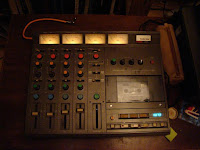A while ago I came across a female hacker/circuit bender under the name r20029 who managed to turn an obsolete Sony Discman into a crispy glitch machine! She baptised it the 'Sony Discbitch' :-)
I managed to hack my own CD player. Here's what it sounds like:
What the hack does is getting access to the anti-skip IC which stores a couple of seconds of audio on a RAM chip. The position of this chip varies from player to player so look up the name of the chip until you find the anti-skip IC. The pins A0 through A9 are DRAM adress pins. If we connect these pins together, we can confuse the machine to get glitchy playback and weird artifacts and noise.
After damaging a couple of CD players I finally managed to solder wires onto the tiny surface mount pins. Hot glue is your friend to make sure you don't accidently pull the wires off the pins when you've soldered it all together.
I think this mod holds great potential for a future module for my modular setup. Maybe have a couple of sample CD's with different material suited for glitchifying.I managed to hack my own CD player. Here's what it sounds like:
What the hack does is getting access to the anti-skip IC which stores a couple of seconds of audio on a RAM chip. The position of this chip varies from player to player so look up the name of the chip until you find the anti-skip IC. The pins A0 through A9 are DRAM adress pins. If we connect these pins together, we can confuse the machine to get glitchy playback and weird artifacts and noise.
After damaging a couple of CD players I finally managed to solder wires onto the tiny surface mount pins. Hot glue is your friend to make sure you don't accidently pull the wires off the pins when you've soldered it all together.
 |
 |















































.PNG)

